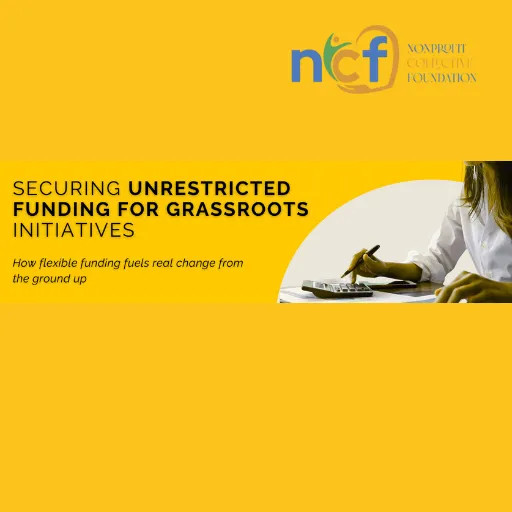
Securing Unrestricted Funding for Grassroots Initiatives
Securing Unrestricted Funding for Grassroots Initiatives
How flexible funding fuels real change from the ground up
In the nonprofit world, flexibility can mean the difference between surviving and thriving. For grassroots initiatives, those deeply embedded in local communities and often operating on limited budgets, flexibility is not a luxury; it's a necessity. That’s why unrestricted funding is one of the most powerful forms of support a funder can offer.
What Is Unrestricted Funding?
Unrestricted funding, also known as general operating support, is funding that is not earmarked for a specific project or activity. Instead, it allows nonprofit organizations the freedom to allocate resources wherever they are needed most, whether that's covering salaries, maintaining infrastructure, investing in technology, or responding to unexpected challenges like natural disasters or economic shifts.
Why It Matters for Grassroots Initiatives
Grassroots organizations are often on the front lines of social impact. They're the ones addressing community needs in real time, feeding families, advocating for local policy changes, providing youth mentorship, or delivering health services. Yet, these organizations often face significant constraints due to tightly restricted grants that don’t cover the real costs of doing their work.
Unrestricted funding changes that dynamic. It allows grassroots nonprofits to:
Cover core operational costs like rent, utilities, and staff salaries.
Invest in growth and sustainability, such as leadership development or technology upgrades.
Respond quickly to emerging needs in the community.
Plan long-term with a greater sense of stability.
According to the Segal Family Foundation, unrestricted funding provides “unlimited advantages,” including stronger organizations, better outcomes, and greater innovation.
The Data Behind the Demand
The demand for unrestricted support is loud and clear:
A report by Charity Digital shows that 88% of charities identify unrestricted funding as one of the most useful things a funder can provide.
In 2021, 61% of 284 U.S. foundations surveyed were making unrestricted grants, an encouraging shift from earlier years.
Of those, 65% intended to continue this practice, according to research published by the European Research Network on Philanthropy (ERNOP).
In one study, 67% of total funding for 28 nonprofits was unrestricted, showing its growing role in nonprofit finance.
This shift is not just anecdotal. Major funders like MacKenzie Scott have reshaped the philanthropic landscape by giving billions in unrestricted support to organizations she trusts, accelerating impact and spurring a broader conversation about trust-based philanthropy.
What’s Holding Back More No-Strings Funding?
Despite its clear benefits, unrestricted funding is still not the norm. The Stanford Social Innovation Review identifies some key barriers:
Lack of trust in grantees’ ability to use funds effectively.
Funder preference for control and measurable outcomes tied to specific projects.
Internal foundation culture which may favor short-term impact over long-term capacity building.
These concerns, while not unfounded, can often be mitigated through transparent relationships, rigorous reporting, and consistent dialogue between funders and grantees.
The Long-Term Payoff
When funders provide unrestricted funding, they’re not just paying for today’s work, they’re investing in tomorrow’s possibilities.
Research from the Dutch Charity Lotteries shows that organizations with unrestricted funding reported improvements in:
Program effectiveness
Staff morale
Innovation
Collaboration capacity
Organizations that are trusted to allocate their resources wisely are often more resilient, agile, and impactful.
How Grassroots Organizations Can Attract Unrestricted Support
While attracting unrestricted funding may seem like an uphill climb, it is entirely achievable with a strategic approach. Here are a few actionable steps:
1. Build Transparent Relationships with Funders
Communicate your mission, your results, and how unrestricted funds have transformed your work in the past (or how they could). Trust builds over time, and strong relationships often lead to greater flexibility.
2. Demonstrate Impact and Accountability
Even if the funding isn’t tied to a specific program, funders still want to see results. Share stories, metrics, and testimonials that illustrate how unrestricted funds translate into real-world outcomes.
3. Tell the Story of Operational Needs
Don’t just highlight the programs, show the story behind what it takes to run them. Include the essential but invisible costs like training, HR, rent, and technology that keep your mission moving forward.
4. Engage in Trust-Based Fundraising
This approach centers equity, humility, and transparency. It means treating funders as partners, not just donors, and inviting them into your organization’s vision and strategy.
5. Target the Right Funders
Some foundations explicitly prioritize unrestricted giving. Use tools like GrantStation, Candid, and FundsforNGOs to identify prospects. Resources such as this guide from FundsforNGOs offer tactical advice for aligning with funders who value flexibility.
A Call to Funders
If we want to see long-term, community-driven change, then we must fund for the long term, and that means offering unrestricted support. By doing so, funders empower nonprofits to adapt, innovate, and grow. For grassroots initiatives in particular, this is not just helpful, it’s transformational.
At the Nonprofit Collective Foundation, we advocate fiercely for greater access to unrestricted funding, especially for under-resourced, grassroots organizations. We believe that with trust and flexible funding, nonprofits can climb higher, reach further, and change the world from the ground up.
